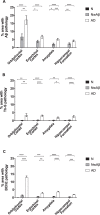Quantification of Butyrylcholinesterase Activity as a Sensitive and Specific Biomarker of Alzheimer's Disease
- PMID: 28453492
- PMCID: PMC5438481
- DOI: 10.3233/JAD-170164
Quantification of Butyrylcholinesterase Activity as a Sensitive and Specific Biomarker of Alzheimer's Disease
Abstract
Amyloid-β (Aβ) plaques are a neuropathological hallmark of Alzheimer's disease (AD); however, a significant number of cognitively normal older adults can also have Aβ plaques. Thus, distinguishing AD from cognitively normal individuals with Aβ plaques (NwAβ) based on Aβ plaque detection is challenging. It has been observed that butyrylcholinesterase (BChE) accumulates in plaques preferentially in AD. Thus, detecting BChE-associated plaques has the potential as an improved AD biomarker. We present Aβ, thioflavin-S, and BChE quantification of 26 postmortem brain tissues; AD (n = 8), NwAβ (n = 6), cognitively normal without plaques (n = 8), and other common dementias including corticobasal degeneration, frontotemporal dementia with tau, dementia with Lewy bodies, and vascular dementia. Pathology burden in the orbitofrontal cortex, entorhinal cortex, amygdala, and hippocampal formation was determined and compared. The predictive value of Aβ and BChE quantification was determined, via receiver-operating characteristic plots, to evaluate their AD diagnostic performance using sensitivity, specificity, and area under curve (AUC) metrics. In general, Aβ and BChE-associated pathology were greater in AD, particularly in the orbitofrontal cortex. In this region, the largest increase (9.3-fold) was in BChE-associated pathology, observed between NwAβ and AD, due to the virtual absence of BChE-associated plaques in NwAβ brains. Furthermore, BChE did not associate with pathology of the other dementias. In this sample, BChE-associated pathology provided better diagnostic performance (AUC = 1.0, sensitivity/specificity = 100% /100%) when compared to Aβ (AUC = 0.98, 100% /85.7%). These findings highlight the predictive value of BChE as a biomarker for AD that could facilitate timely disease diagnosis and management.
Keywords: Acetylcholinesterase; Alzheimer’s disease; amyloid-β; butyrylcholinesterase; tauopathies; thioflavin-S; α-synucleinopathy.
Figures





Similar articles
-
Butyrylcholinesterase-knockout reduces fibrillar β-amyloid and conserves 18FDG retention in 5XFAD mouse model of Alzheimer's disease.Brain Res. 2017 Sep 15;1671:102-110. doi: 10.1016/j.brainres.2017.07.009. Epub 2017 Jul 17. Brain Res. 2017. PMID: 28729192
-
Interaction of exogenous acetylcholinesterase and butyrylcholinesterase with amyloid-β plaques in human brain tissue.Chem Biol Interact. 2024 May 25;395:111012. doi: 10.1016/j.cbi.2024.111012. Epub 2024 Apr 20. Chem Biol Interact. 2024. PMID: 38648920
-
Interaction of Exogenous Butyrylcholinesterase with β-Amyloid Plaques in 5XFAD/Butyrylcholinesterase-Knockout Mouse Brain.Curr Alzheimer Res. 2021;18(6):470-481. doi: 10.2174/1567205018666210827122704. Curr Alzheimer Res. 2021. PMID: 34455970
-
Butyrylcholinesterase as a Diagnostic and Therapeutic Target for Alzheimer's Disease.Curr Alzheimer Res. 2016;13(10):1173-7. doi: 10.2174/1567205013666160404120542. Curr Alzheimer Res. 2016. PMID: 27040140 Review.
-
The Role of Butyrylcholinesterase and Iron in the Regulation of Cholinergic Network and Cognitive Dysfunction in Alzheimer's Disease Pathogenesis.Int J Mol Sci. 2021 Feb 18;22(4):2033. doi: 10.3390/ijms22042033. Int J Mol Sci. 2021. PMID: 33670778 Free PMC article. Review.
Cited by
-
A method for the efficient evaluation of substrate-based cholinesterase imaging probes for Alzheimer's disease.J Enzyme Inhib Med Chem. 2023 Dec;38(1):2225797. doi: 10.1080/14756366.2023.2225797. Epub 2023 Jun 26. J Enzyme Inhib Med Chem. 2023. PMID: 38061987 Free PMC article.
-
Synthesis and Initial Characterization of a Reversible, Selective 18F-Labeled Radiotracer for Human Butyrylcholinesterase.Mol Imaging Biol. 2021 Aug;23(4):505-515. doi: 10.1007/s11307-021-01584-2. Epub 2021 Mar 3. Mol Imaging Biol. 2021. PMID: 33660167 Free PMC article.
-
Marine Sources of DHA-Rich Phospholipids with Anti-Alzheimer Effect.Mar Drugs. 2022 Oct 25;20(11):662. doi: 10.3390/md20110662. Mar Drugs. 2022. PMID: 36354985 Free PMC article. Review.
-
Risk Variants in Three Alzheimer's Disease Genes Show Association with EEG Endophenotypes.J Alzheimers Dis. 2021;80(1):209-223. doi: 10.3233/JAD-200963. J Alzheimers Dis. 2021. PMID: 33522999 Free PMC article.
-
Synthesis and Initial Characterization of a Selective, Pseudo-irreversible Inhibitor of Human Butyrylcholinesterase as PET Tracer.ChemMedChem. 2021 May 6;16(9):1427-1437. doi: 10.1002/cmdc.202000942. Epub 2021 Mar 1. ChemMedChem. 2021. PMID: 33645891 Free PMC article.
References
-
- World Health Organization and Alzheimer’s Disease International (2012), p, 112.
-
- World Health Organization, Fact Sheet on Dementia, http://www.who.int/mediacentre/factsheets/fs362/en/
-
- Alzheimer’s Disease International, World Alzheimer Report 2015: The Global Impact of Dementia, https://www.alz.co.uk/research/world-report-2015
-
- McKhann GM, Knopman DS, Chertkow H, Hyman BT, Jack CR Jr, Kawas CH, Klunk WE, Koroshetz WJ, Manly JJ, Mayeux R, Mohs RC, Morris JC, Rossor MN, Scheltens P, Carrillo MC, Thies B, Weintraub S, Phelps CH (2011) The diagnosis of dementia due to Alzheimer’s disease: Recommendations from the National Institute on Aging-Alzheimer’s Association workgroups on diagnostic guidelines for Alzheimer’s disease. Alzheimers Dement 7, 263–269. - PMC - PubMed
Publication types
MeSH terms
Substances
Grants and funding
LinkOut - more resources
Full Text Sources
Other Literature Sources
Medical
Miscellaneous

